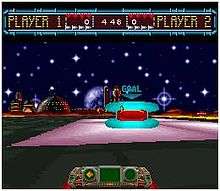Space Football: One on One
Space Football: One on One, known in Japan as Super Linear Ball (スーパーリニアボール), is a video game developed by Bits Studios and released in 1992 exclusively for the Super Nintendo Entertainment System. The game takes place in the future with two athletes attempting to score goals against each other.[3]
| Space Football: One on One | |
|---|---|
 North American cover art | |
| Developer(s) | Bits Studios |
| Publisher(s) | Acclaim Japan, Triffix Entertainment |
| Designer(s) | Jon Stuart[1] |
| Artist(s) | Stephen Robertson |
| Composer(s) | Colin Bennun |
| Platform(s) | Super NES |
| Release | |
| Genre(s) | Sports |
| Mode(s) | Single-player Multiplayer (up to two players) |
Gameplay

Using retro grav hovercrafts, these two athletes must gain possession of a hovering ball. There are twelve different drivers to choose from.[4] 32 levels offer different obstacles and level design for players to skilfully move the ball around.[5]
Features included mode 7 scrolling. The player moves the ball up the field by shooting it. Obstacles are thrown in the player's way to block progress.[3] This is to replace the lack of defenders used in an American football game played in the real world. These obstacles include magnetic flux fields that drains the player's energy and spincycles that twist the player out of control.[6] Every background has a science fiction look to it with the stars and the space colony being shown. The goal scoring areas are similar to soccer nets but without the goalkeeper blocking it.
There is a timer announcing the number of time units left in the game.[1] The player is not allowed to hold the ball after four seconds.[4]
References
- "Credits/additional game information". MobyGames. Retrieved 2011-11-16.
- "Release information". GameFAQs. Retrieved 2010-04-19.
- "Video game overview". GameSpot. Retrieved 2010-04-20.
- "Additional video game overview". Allgame. Retrieved 2010-04-22.
- "Number of levels" (in Japanese). Carnophage. Retrieved 2013-01-04.
- "Overview of the obstacles". GameSpy. Retrieved 2010-05-05.